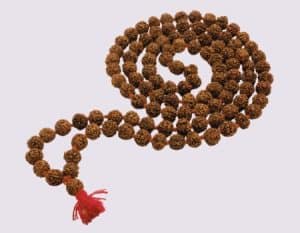Japa is the spiritual practice of the repetition of a mantra, or a holy name. Mantras are Sanskrit invocations of the Supreme Being. They are not composed by any human but exist in the universe in a latent state as sound energies. They were revealed to spiritual masters in meditation and codified in the ancient scriptures.
Japa trains the mind to focus on one line of thinking. It enhances concentration and makes the mind single-pointed. This is why japa is an excellent preliminary discipline for meditation.
 To keep the mind focused on the mantra, a mala (a rosary) is used. The beads are turned one by one with each repetition of the mantra.
To keep the mind focused on the mantra, a mala (a rosary) is used. The beads are turned one by one with each repetition of the mantra.
A mala with 108 beads is traditionally used. But malas of 27 or 54 beads are also common. 108 is a significant spiritual number and 27 or 54 beads are a quarter or half of 108 respectively.
Mantras for the practice of japa
Below are some examples of mantras you can use for your japa practice. The names of the deities invoked in the mantras below such as Lord Ganesha and Lord Shiva carry different vibrations and appeal to different people. You can choose a mantra that invokes the qualities that you want to attract in your life and in your character.
Om Shree Maha Ganapataye Namah (Prostrations to the great Lord Ganesha). Lord Ganesha is worshipped by seekers who want to invoke auspiciousness in their lives. Lord Ganesha is also the remover of obstacles and bestower of success.
Om Namah Shivaya (Prostrations to Lord Shiva.) Lord Shiva represents purity, meditation, compassion, and the energy of transformation.
Om Shree Ramaya Namah (Prostrations to Lord Rama). Lord Rama is the manifestation of divinity that demonstrates through his life and noble deeds how to live a righteous life, remaining balanced and calm throughout. Lord Rama’s qualities are nobility of character, adherence to duty, gentleness that is not meek but ready to stand up and fight for the good.
Hari Om (Om Vishnu) By chanting this mantra, one invokes the Supreme in the form of Vishnu also known as Hari. It is that aspect of the divinity that forgives past actions and destroys negative deeds.
OM (Invocation to the Supreme Reality.) All Mantras invoke different expressions of the one God or Supreme Truth. If you don’t know which deity to worship through your japa practice, the easiest and most potent mantra is, OM. My guru, Swami Chinmayananda explains that “Om is accepted as being both one with Brahman [the Supreme Truth or God] and also as the medium that connects the human being to God.”
How to practice japa
Dedicate a sacred place and time for your japa and meditation practice. Create an altar where you can set out an image of the deity associated with your mantra and symbols that will uplift and bring peace to your mind.
Sit comfortably, crossed-legged on the floor or on a chair with your back upright. Relax your body especially your face, neck, shoulders, and arms.
Gently gaze at the symbol of your chosen deity for some time. Then close your eyes and feel the presence of the deity in your spiritual heart which lies slightly right of your physical heart. Visualize the form of the deity exactly as you remember it.
Before starting your japa practice, repeat your chosen mantra a few times with love to invoke a feeling of devotion in your heart.
 Take up your mala in your hand. Let it hang on your ring finger with the meru bead (the marker bead with the threads on it) facing you. Your little finger remains below your ring finger. You will use your thumb and middle finger to move the beads down towards you one at a time with each mantra you chant. Your index finger is not engaged in this practice as it represents duality or the otherness of things.
Take up your mala in your hand. Let it hang on your ring finger with the meru bead (the marker bead with the threads on it) facing you. Your little finger remains below your ring finger. You will use your thumb and middle finger to move the beads down towards you one at a time with each mantra you chant. Your index finger is not engaged in this practice as it represents duality or the otherness of things.
Rest your hand with the mala on your knee if you’re sitting cross-legged or in your lap if you’re in a chair.
Now you’re ready to begin. Chant your mantra slowly with full awareness. When you complete the first chant, move the first bead next to the meru downwards towards you. Chant the second time and move the second bead down. Chant again, move another bead down and so on. As you keep going in this way, the meru will circle down and back up until you’ve moved every bead on the mala. When you arrive back at the meru, you would have repeated your mantra 108 times. You may choose to do more rounds of your mala.
The meru is not usually counted in the total count of 108. It is merely a marker. And so, there should be 109 beads in your mala.
In the video below I demonstrate the practice of japa using the mantra, Om Namah Shivaya.
While doing japa, try to bring in a devotional feeling. It is the remembrance and feeling of love towards God that enhances the power of the japa practice. It is that feeling that will purify the mind.
Evoking devotion takes time and practice and so it’s inevitable that our japa will seem rather mechanical in the beginning. But as we progress in our practice, we will be able to chant with feeling. According to spiritual master, Swami Tejomayananda, doing regular and long japa with feeling can release us from the cycle of birth and death. He tells us that japa must be undertaken for purity of mind, to cultivate love for God and to live a God-centred life.
Japa can be practiced in three ways—audibly (others around you can hear it), softly (only you can hear it) and mentally (silently, within your own mind).
Repeating your mantra out loud is the easiest. It doesn’t require too much concentration and is a good way to do japa when you first start your practice.
When your mind becomes quiet through this practice, you will find that you will naturally want to chant softly. This type of japa is easier to do once you can recite aloud with focus.
When you’re able to chant softly with full attention, it will become easier to repeat it in your mind. You will still use your mala in the same way, but only you will hear your mantra in your own mind.
Japa done in this way quietens and naturally leads the mind into meditation.
Japa is a yoga
A yoga is a spiritual discipline. Japa is a yoga which can be practiced anywhere, with or without a mala. What is needed is a desire to remember and grow in love for God through the chanting of a divine name.
This desire and the sincere practice of japa purifies us and protects us. The word mantra itself means, “that which protects or saves”. Keeping God’s name on our lips, in our heart, and mind protects us from all sorrows, fears and regrets.
Japa is indeed an easy yet powerful spiritual discipline.
Like this post? Sign up for the free fortnightly Spiritual Solutions Newsletter and receive the latest articles, news and updates in your email inbox!














Thank you Manisha for how to do the Japa. It is very soothing .
Thank you for your wonderful postings.
Thanks Norma. I’m happy you enjoyed it!